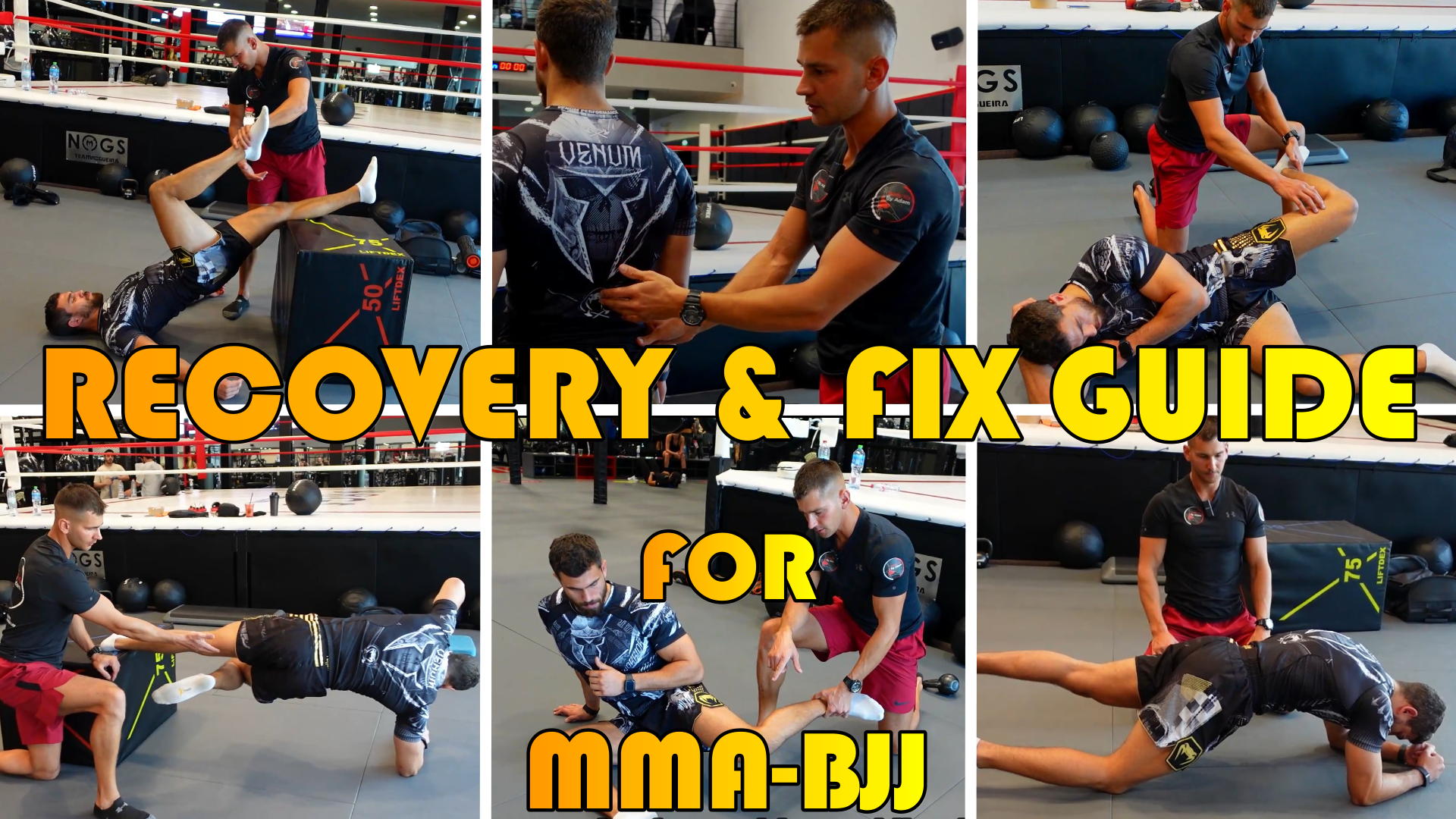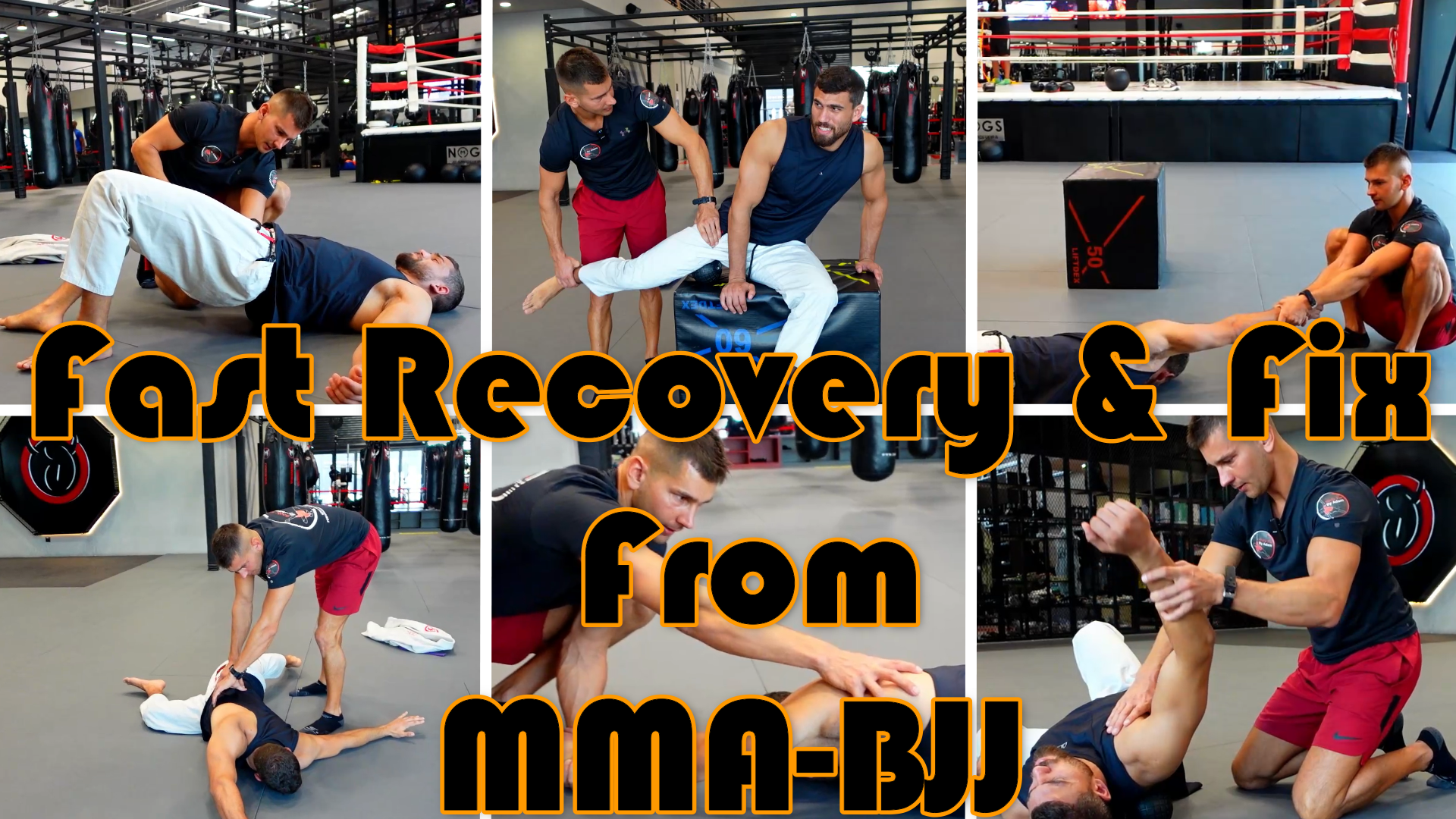
MMA (Mixed Martial Arts) training is a physically demanding discipline that requires a combination of strength, agility, endurance, and technique. In order to excel in combat sports like MMA, athletes must prioritize injury prevention and mobility training. As an MMA fighter, it is imperative to recognize the paramount significance of specific strength and speed training in optimizing your performance, alongside the implementation of a meticulous recovery program. To ensure that you maintain optimal health and remain fight-ready, I invite you to explore my comprehensive MMA-BJJ Guide to Recovery and Injury Prevention. This guide has been meticulously crafted to assist fighters like you in achieving peak physical condition while mitigating the risk of injuries that can impede your progress. https://courses.bodyfixbyadam.com/cou… It’s important for MMA athletes to work with qualified coaches, trainers, and healthcare professionals who can provide guidance on appropriate mobility exercises and injury prevention strategies. They can develop personalized training plans that incorporate mobility work, rehab exercises, and injury prevention techniques tailored to the individual fighter’s needs. Remember, investing time and effort in mobility and rehab exercises is not only crucial for injury prevention but also for maximizing performance and ensuring longevity in the demanding world of combat sports like MMA. @pouyarahmani8138 @DubaiProWrestling @BellatorMMA #mmafighter #mmatraining #mobility #injuryprevention #wrestling #ufctraining #workoutmotivation


Proper mobility, rehabilitation, and warm-up training are crucial aspects of injury prevention in MMA. By incorporating these practices into a fighter’s routine, they can enhance performance, reduce the risk of injuries, and optimize their overall physical well-being. Additionally, specific training for speed, power, and agility is essential for developing punching power, a key component of an MMA fighter’s skill set.
Importance of Proper Mobility: In MMA, mobility refers to the ability to move freely and efficiently through a full range of motion. It plays a significant role in injury prevention by improving joint health, reducing muscle imbalances, and enhancing overall movement quality. Good mobility allows fighters to perform techniques with proper form, decreasing the likelihood of strain or trauma. Incorporating exercises that promote joint mobility, such as dynamic stretching and mobility drills, helps fighters maintain optimal flexibility and range of motion, reducing the risk of injuries during training and fights.
Rehabilitation for Injury Prevention: Injuries are common in MMA due to the physically demanding nature of the sport. However, proper rehabilitation is crucial for preventing recurring injuries and minimizing their long-term effects. When fighters sustain an injury, engaging in a structured rehabilitation program under the guidance of a medical professional helps restore strength, flexibility, and stability to the injured area. Failing to rehabilitate adequately can lead to compensation patterns and imbalances that increase the risk of future injuries. By focusing on rehabilitation, fighters can address the root causes of injuries, strengthen weak areas, and ensure a safe return to training and competition.
Importance of Warm-Up Training: Warming up before any physical activity, including MMA training or fights, is vital for injury prevention. A thorough warm-up routine increases blood flow, raises core body temperature, and prepares the muscles, tendons, and joints for the upcoming physical demands. It helps improve joint lubrication, muscle elasticity, and neural activation, enhancing overall performance while reducing the risk of strains, sprains, and muscle tears. A warm-up should include dynamic stretching, mobility exercises, and sport-specific movements to prepare the body adequately and optimize performance during training or competition.
Performance Training for Punching Power: Punching power is a critical attribute for success in MMA. To develop optimal punching power, a well-rounded training approach should incorporate the following components:
Strength Training: Building overall strength through compound exercises such as squats, deadlifts, bench presses, and overhead presses helps increase the force generated in punches. Incorporating exercises that target the core, hips, and upper body enhances the transfer of power from the lower body to the fists.
Plyometric Training: Plyometric exercises involve rapid stretching and contracting of muscles, which improves power output and explosive strength. Plyometric movements such as medicine ball throws, clap push-ups, and box jumps help develop the fast-twitch muscle fibers responsible for generating power in punches.
Speed and Agility Training: Enhancing speed and agility allows fighters to deliver fast and accurate punches while evading opponents’ strikes. Utilizing drills that focus on footwork, reaction time, and quick changes in direction can improve a fighter’s ability to close the distance and generate power in their punches.
Technique and Timing: Perfecting punching technique is paramount for maximizing power. Working on proper form, weight transfer, and hip rotation allows fighters to generate more force with each strike. Additionally, developing timing and rhythm through drills and sparring can improve the accuracy and effectiveness of punches.
It’s important to note that training should be tailored to an individual fighter’s specific needs, abilities, and training level. Working with a knowledgeable coach or trainer can help create a comprehensive and customized training program that targets speed, power, and agility while considering the fighter’s unique attributes and goals.

To build ultimate performance as an MMA fighter, several key factors should be prioritized. These factors encompass physical attributes, technical skills, mental fortitude, and overall conditioning. Here are the most important aspects to focus on:
Conditioning and Endurance: MMA is a highly demanding sport that requires exceptional cardiovascular endurance, muscular endurance, and overall stamina. Incorporating high-intensity interval training (HIIT), aerobic and anaerobic conditioning, and sport-specific drills into training regimens helps fighters develop the necessary endurance to sustain a high pace throughout the fight.
Strength and Power: Building strength and power is crucial for generating force in strikes, takedowns, and grappling maneuvers. Incorporating resistance training, such as weightlifting and plyometrics, helps increase overall strength, explosive power, and muscular endurance. Focusing on compound movements like deadlifts, squats, and bench presses, as well as explosive exercises like medicine ball throws and kettlebell swings, can enhance strength and power output.
Technical Skills: Mastering the technical aspects of MMA is vital for success. This includes proficiency in striking (boxing, kickboxing, Muay Thai), grappling (Brazilian Jiu-Jitsu, wrestling), and transitions between these disciplines. Consistent practice, drilling, and sparring under the guidance of experienced coaches can refine technique, improve timing, and enhance overall skill level.
Agility and Speed: Agility and speed are critical attributes in MMA, allowing fighters to evade strikes, close the distance, and deliver rapid combinations. Agility drills, footwork exercises, and reaction training improve quickness, coordination, and the ability to change directions swiftly. Incorporating speed-focused drills and sprints enhances overall speed and explosiveness.
Mental Strength and Focus: MMA fights can be mentally challenging, requiring fighters to stay composed, focused, and resilient under pressure. Developing mental fortitude, discipline, and mental toughness through techniques like visualization, mindfulness, and mental conditioning exercises is essential. This helps fighters maintain focus, overcome adversity, and make sound decisions during fights.
Strategy and Fight IQ: MMA is a strategic sport where fighters must analyze their opponents, identify weaknesses, and develop effective game plans. Developing fight intelligence and a strong understanding of different fighting styles allows fighters to capitalize on advantages and exploit their opponents’ weaknesses. Studying fights, analyzing techniques, and working closely with coaches to formulate effective strategies are important aspects of fight preparation.
Recovery and Injury Prevention: Proper recovery and injury prevention strategies are crucial for maintaining optimal performance. Adequate rest, nutrition, hydration, and sleep are essential for recovery. Regularly incorporating mobility exercises, stretching, and recovery modalities like massage, foam rolling, and ice baths can help prevent injuries and improve overall longevity in the sport.
It’s important to note that these factors should be integrated into a well-rounded training program tailored to the individual fighter’s goals, abilities, and strengths. Working with knowledgeable coaches, trainers, and medical professionals can help create a comprehensive plan that addresses all aspects of performance development.
Recover FASTER From MMA and BJJ (BEST WAY TO FIX IMBALANCES AND PAIN ISSUES!)

Recovery and injury prevention are crucial aspects of an MMA fighter’s training regimen. By implementing proper recovery strategies and injury prevention techniques, fighters can enhance performance, reduce the risk of injuries, and promote overall longevity in the sport.
Are you a jiu-jitsu or MMA Fighter who suffers with Shoulder, hips and lower back pain? If so, this video shows why you may be suffering and what you can do. Jiu-jitsu (BJJ) can be very hard on the body and often times the compression, stacking, and constant beating of the lower back cause an injury. Over time, compression can lead to a disc herniation, sciatica, or disc bulge. You may also be familiar with this condition as it is referred to as a slipped disc. In these types of injuries, the pain in the lower back can be deep, dull, and achy but it can also be sharp, and intense with numbness, tingling, and burning down the leg. With this condition, it is very important that you seek treatment and rehabilitation of the low back. Doing this can help your recovery and get you back to training faster. Want More Info? I have online courses, and programs, and offer Virtual Sessions to help. Rehab & Mobility Program: https://courses.bodyfixbyadam.com/
The Ultimate Guide to Preventing and Treating BJJ-MMA Injuries offers professional and amateur fighters and fans alike the sound professional advice they need to prevent and treat injuries.
Target Your Training!
See how the focus of the Mobility and Stability Program can help you. This Ultimate Guide For Fighter’s will improve your basic physical fitness and wellbeing, with specific training focuses. While some program benefits may be a higher percentage than others, you will see improvement in all categories.
Injury Prevention, Post Workout Tips, Fixing Muscle Imbalances, Top Posture Correction Exercises and more.
LINK TO ONLINE COURSE – The Ultimate Guide to Preventing and Treating BJJ-MMA Injuries
https://courses.bodyfixbyadam.com/cou…


